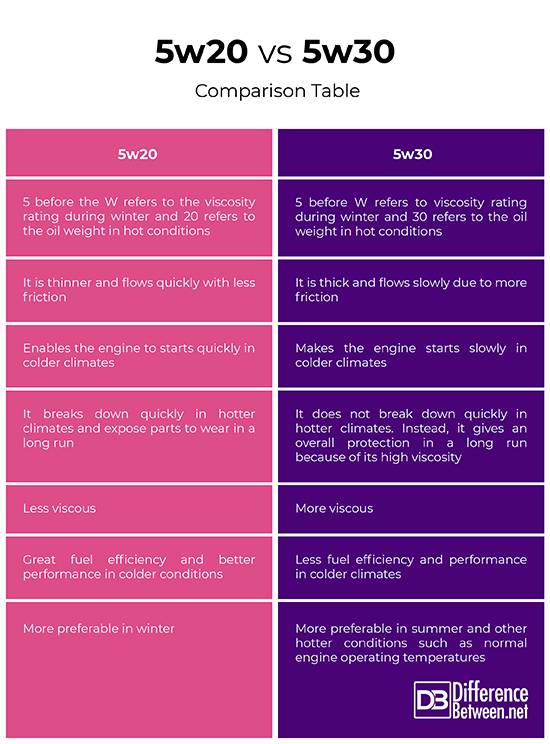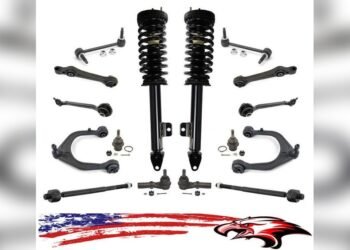Choosing the right motor oil for your vehicle can be confusing. Two popular options are 5W20 and 5W30.
Understanding the differences between these oils is crucial for your engine’s health. Both 5W20 and 5W30 have unique properties that suit different driving conditions and engine types. This comparison will help you decide which oil fits your needs best. By exploring their characteristics, you can ensure optimal performance and longevity for your vehicle.
Let’s dive into the key aspects of 5W20 and 5W30 to make an informed decision.

Credit: www.differencebetween.net
Introduction To Engine Oils
Engine oils are essential for the smooth functioning of your vehicle’s engine. They reduce friction and wear, keeping the engine parts moving seamlessly. The right engine oil ensures your engine runs efficiently and lasts longer.
Importance Of Engine Oil
Engine oil lubricates moving parts. It helps in reducing friction, which causes wear and tear. Without proper lubrication, engines can overheat and fail. Engine oil also helps in cleaning the engine by suspending dirt and particles. This prevents sludge buildup and keeps the engine clean.
Engine oil also prevents corrosion. It forms a protective layer on metal parts, preventing rust. Additionally, it helps in sealing gaps between the piston and cylinder. This improves engine performance and efficiency.
Role Of Viscosity
Viscosity is a measure of an oil’s resistance to flow. It indicates how thick or thin the oil is. Thicker oils have higher viscosity, while thinner oils have lower viscosity. The Society of Automotive Engineers (SAE) developed a grading system for oil viscosity, like 5W20 and 5W30.
Viscosity affects the oil’s performance. In colder temperatures, a lower viscosity oil, like 5W20, flows easier. This ensures quick lubrication during cold starts. In hotter climates, a higher viscosity oil, like 5W30, provides better protection under high heat and stress.
| Viscosity Grade | Cold Temperature | Hot Temperature |
|---|---|---|
| 5W20 | Flows easily | Less protective under high heat |
| 5W30 | Moderate flow | Better protection under high heat |
Choosing the right viscosity depends on your vehicle and climate. Refer to your vehicle’s manual for the recommended oil viscosity. This ensures optimal engine performance and longevity.
Understanding Oil Grades
Choosing the right motor oil is crucial for engine performance. Understanding oil grades helps you make the best decision. This article explains the difference between 5W20 and 5W30 oil. These numbers and letters tell you how the oil performs at different temperatures.
What 5w20 Means
The “5W” in 5W20 stands for winter. It indicates the oil’s viscosity at low temperatures. The number “5” shows the oil’s thickness when cold. The lower the number, the thinner the oil. This means 5W20 oil flows well in cold weather.
The number “20” shows the oil’s viscosity at high temperatures. It tells you how thick the oil remains when the engine is hot. 5W20 oil is thinner at high temperatures than 5W30. This can lead to better fuel efficiency.
What 5w30 Means
Similar to 5W20, the “5W” in 5W30 also stands for winter. It shows the oil’s viscosity at cold temperatures. The number “5” again indicates a thinner oil when cold. This makes it good for cold weather starts.
The number “30” shows the oil’s viscosity at high temperatures. 5W30 oil is thicker than 5W20 when the engine is hot. This can offer better protection for the engine under high heat. It is often used in warmer climates or for heavy-duty engines.
Performance In Different Temperatures
Choosing between 5W20 and 5W30 motor oils can be confusing. Each oil performs differently in various temperatures. Understanding their performance in cold and hot weather helps you make an informed decision for your vehicle.
Cold Weather Performance
In cold weather, engine oil needs to flow easily. This ensures proper lubrication during startup. 5W20 and 5W30 both have a viscosity rating of 5 in cold conditions. This means they perform similarly when temperatures drop.
The “W” in the oil ratings stands for winter. Both oils are designed to flow well at low temperatures. But 5W20 is thinner at operating temperature than 5W30. This makes 5W20 slightly better for very cold climates.
Hot Weather Performance
Hot weather requires oil that can maintain its thickness. It prevents the engine parts from wearing out. Here, 5W30 has an advantage. The number 30 in 5W30 indicates it is thicker at high temperatures compared to 5W20.
5W30 is better for hot climates or heavy-duty driving. It provides better protection against heat and engine wear. This makes 5W30 a suitable choice for summer or high-performance vehicles.
| Feature | 5W20 | 5W30 |
|---|---|---|
| Viscosity in Cold Weather | 5 | 5 |
| Viscosity in Hot Weather | 20 | 30 |
| Best for Cold Weather | Yes | Yes |
| Best for Hot Weather | No | Yes |
Fuel Economy Comparison
When choosing motor oil, fuel economy is a key factor. The oil you select can impact your vehicle’s fuel efficiency. Comparing 5W20 and 5W30 oils can help determine which is better for your car’s fuel consumption.
5w20 And Fuel Efficiency
5W20 oil is designed for better fuel economy. This oil has a lower viscosity, which means it flows more easily at lower temperatures. Reduced friction inside the engine can lead to improved fuel efficiency.
Many modern vehicles use 5W20 oil to meet fuel economy standards. The thinner consistency helps the engine run smoothly and can reduce fuel consumption. This can be beneficial for drivers seeking to save on gas costs.
5w30 And Fuel Efficiency
5W30 oil is slightly thicker than 5W20. This oil provides better protection at higher temperatures but may have a minor impact on fuel economy. The increased viscosity can result in slightly more friction compared to 5W20.
While 5W30 may not offer the same fuel efficiency benefits as 5W20, it provides extra protection. This can be crucial in warmer climates or for vehicles that operate under heavy loads. It balances fuel economy with engine protection.
| Oil Type | Fuel Efficiency | Engine Protection |
|---|---|---|
| 5W20 | High | Moderate |
| 5W30 | Moderate | High |
Choosing between 5W20 and 5W30 depends on your priorities. If fuel economy is your main concern, 5W20 may be the better choice. For those needing extra protection in harsh conditions, 5W30 could be more suitable.
Engine Protection And Longevity
Choosing the right oil for your engine impacts its protection and longevity. The debate between 5W20 and 5W30 oils revolves around this key aspect. Each oil type has unique properties that contribute to engine health. Understanding these differences helps you make an informed decision for your vehicle.
5w20 For Engine Health
5W20 oil flows easily at low temperatures. This quick lubrication reduces wear during cold starts. It is less viscous at operating temperatures. This means the oil circulates faster, reaching all engine parts quickly. Reduced friction improves fuel efficiency. The engine runs smoothly, ensuring optimal performance. This oil type is often recommended for modern engines designed for lighter oils. Regular use keeps the engine clean and reduces sludge buildup.
5w30 For Engine Health
5W30 oil provides better protection under high temperatures. This higher viscosity ensures a thicker oil film on engine parts. The oil does not break down easily under stress. It is ideal for engines operating under heavy loads or high speeds. This oil type helps maintain stable viscosity, offering reliable lubrication. It is suitable for older engines that require thicker oils for protection. Using 5W30 can reduce engine wear and extend its life.

Credit: acurazine.com
Manufacturer Recommendations
Choosing between 5W20 and 5W30 oil can be challenging. The best choice depends on your car’s specific needs. Manufacturer recommendations play a crucial role in this decision. Always follow what your car’s manufacturer suggests. It ensures the best performance and longevity for your vehicle.
Reading Your Car’s Manual
Your car’s manual is a valuable resource. It contains detailed information about the right oil type. For example, it will specify if you should use 5W20 or 5W30. This information is based on extensive testing by the manufacturer. Following these recommendations helps maintain engine health.
Ignoring the manual can lead to problems. The wrong oil type can affect engine efficiency. It might also lead to increased wear and tear. Always take a few minutes to read the manual. It saves you from bigger issues later.
Impact On Warranty
Using the recommended oil type is crucial for your car’s warranty. Manufacturers often require specific oil types to keep the warranty valid. Using 5W20 when 5W30 is required, or vice versa, can void the warranty. This means any damage might not be covered.
Stick to the recommended oil type to avoid such issues. It ensures you can claim warranty benefits if needed. It also shows you are taking good care of your vehicle. This can be important if you ever decide to sell your car.
Common Misconceptions
When discussing 5W20 vs 5W30 motor oils, several common misconceptions can cause confusion. Understanding these misconceptions helps car owners make informed choices.
Mixing Oils
One major misconception is that mixing 5W20 and 5W30 oils can harm your engine. In reality, mixing them in small amounts is usually safe. Both oils have similar properties but different viscosities.
Mixing them won’t damage your engine immediately. It’s important to use the oil recommended by your manufacturer. Consistently using the wrong oil can lead to long-term issues.
| Oil Type | Viscosity |
|---|---|
| 5W20 | Thinner at high temperatures |
| 5W30 | Thicker at high temperatures |
Switching Between Oils
Another common misconception is that switching between 5W20 and 5W30 can harm your engine. This is not true if you follow proper guidelines. It is possible to switch oils without causing damage.
Always consider the climate and your vehicle’s needs. For example:
- 5W20 works well in colder climates.
- 5W30 is better for hotter climates.
Switching oils seasonally can be beneficial. Always check the manufacturer’s recommendations before making a change.
Choosing The Right Oil
Choosing the right oil for your car is crucial. It ensures the engine runs smoothly and lasts longer. The most common choices are 5W20 and 5W30. Each has its pros and cons. Making the right choice depends on several factors. Let’s explore these factors in detail.
Driving Conditions
Your driving conditions play a big role. If you drive in cold weather, 5W20 might be better. It flows well at low temperatures, ensuring your engine starts easily. On the other hand, if you drive in hot weather, 5W30 is a better choice. It provides better protection at high temperatures.
Consider your driving habits too. Do you drive short distances often? Or do you take long highway trips? Short trips can lead to engine wear. In this case, 5W30 might offer better protection. For long trips, 5W20 could be more efficient.
Personal Preferences
Personal preferences also matter. Some people prefer thinner oils like 5W20. They believe it offers better fuel efficiency. Others prefer thicker oils like 5W30. They think it provides better engine protection.
Consider the age of your car as well. Newer cars might run better on 5W20. Older cars, especially those with high mileage, might benefit more from 5W30. It can help reduce engine wear and tear.
Here is a quick comparison:
| Factor | 5W20 | 5W30 |
|---|---|---|
| Temperature Range | Better in cold | Better in hot |
| Fuel Efficiency | Higher | Moderate |
| Engine Protection | Good | Better |
In summary, both oils have their strengths. Your choice should depend on your driving conditions and personal preferences. Always refer to your car’s manual for the manufacturer’s recommendation.

Credit: www.youtube.com
Frequently Asked Questions
What Is The Main Difference Between 5w20 And 5w30?
5W20 is thinner at high temperatures. 5W30 is thicker, offering more protection.
Which Oil Is Better For Fuel Efficiency, 5w20 Or 5w30?
5W20 often provides better fuel efficiency due to its thinner nature.
Can I Use 5w30 Instead Of 5w20?
Yes, but check your car’s manual first. Some engines are designed for specific oils.
Is 5w30 Better For Hot Climates?
Yes, 5W30 is better for hot climates. It maintains better viscosity at high temperatures.
Does 5w20 Or 5w30 Offer Better Engine Protection?
5W30 offers better engine protection, especially in high heat or under heavy loads.
Conclusion
Choosing between 5W20 and 5W30 depends on your car’s needs. Check your vehicle’s manual for the recommended oil. 5W20 works well in colder climates. 5W30 is better for warmer temperatures. Both oils protect your engine. Regular oil changes keep your car running smoothly.
Always use the oil type your car manufacturer suggests. This ensures optimal performance and longevity.

















